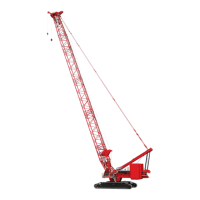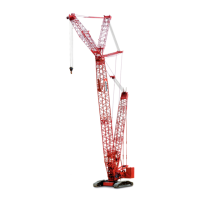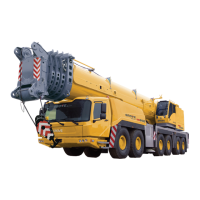Manitowoc Published 11-22-17, Control # 257-02 7-1
MLC300 SERVICE/MAINTENANCE MANUAL POWER TRAIN
SECTION 7
POWER TRAIN
BATTERIES
Battery Safety
Battery Gases Are Explosive
Avoid sparks while charging batteries. Do
not disturb the connection between the
batteries until the charger is turned off.
Another source of explosion lies in the
reverse connection of the charging
equipment. This hazard is present with all
types of chargers, but particularly in the
case of high-rate equipment. Carefully
check the connections before turning on
the charger.
Jump-Starting a Battery
Improper use of a booster battery to start a crane presents
an explosion hazard. To minimize this hazard, the following
procedure is suggested.
1. Connect one end of each jumper cable to the proper
battery terminals on the crane to be started. Do not allow
the cable ends to touch.
2. Connect the positive cable to the positive terminal of the
booster battery.
3. Connect the remaining cable to the frame or block of the
starting vehicle. Never connect it to the grounded
terminal of the starting vehicle.
Causes of Battery Failure
A battery should never be left in a discharged state. When
discharged, it rapidly sulfates and, unless recharged within
hours, will permanently lose capacity.
Overcharging
Overcharging is one cause of battery failure and is most
often caused by a malfunctioning voltage regulator.
Excessive heat is the result of overcharging. Overheating
causes the plates to warp, which can damage the separators
and cause a short circuit within a cell. This bubbling and
gassing of the electrolyte can wash the active material from
the plates, reducing the battery’s capacity or causing an
internal short.
Undercharging
Undercharging can cause a type of sulfate to develop on the
plates. The sulfate reduces the battery capacity and causes
strains in the positive plates, which cause plate buckling.
Buckled plates can pinch the separators and cause a short
circuit. An undercharged battery is not only unable to deliver
power, but also may freeze (see Table 7-1
).
Table 7-1. Battery Freeze Points
Lack of Water
The plates must be completely covered with electrolyte. If
the plates are exposed, the high acid concentration will char
and disintegrate the separators. The plates cannot take a full
charge if they are not completely covered by the electrolyte.
WARNING
Explosion Hazard!
Batteries can violently explode, spraying acid, if a spark or
flame is brought too close. The room or compartment in
which batteries are stored must be ventilated and away
from flames or sparks.
Chemical Burn Hazard!
Battery electrolyte can cause severe burns. If electrolyte
comes in contact with eyes, skin, or clothing, the area
must be immediately flushed with large amounts of water.
Seek medical attention in the event of an electrolyte burn.
Always wear eye protection when servicing batteries.
State of Charge
Specific
Gravity
Freeze Point
°C (°F)
100% 1.26 -57 (-70)
75% 1.23 -38 (-36)
50% 1.20 -26 (-15)
25% 1.17 -19 (-2)
0% 1.11 -8 (18)

